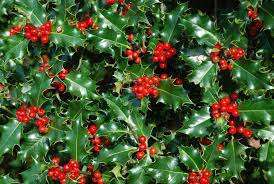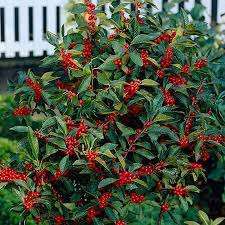 While their shiny, green, prickly leaves and their mostly red berries (drupes) often evoke wintertime and the holiday season, the hollies (Ilex) deserve much more than a month of adoration a year. Few other groups of shrubs and trees contribute more to evergreen foundation plantings and general mixed borders than Ilex, but that is just the start to their merits. Continued crosses between North American, European and Asian species have produced an ever-expanding and -improving range of garden cultivars sure to fulfill a need in the garden.
While their shiny, green, prickly leaves and their mostly red berries (drupes) often evoke wintertime and the holiday season, the hollies (Ilex) deserve much more than a month of adoration a year. Few other groups of shrubs and trees contribute more to evergreen foundation plantings and general mixed borders than Ilex, but that is just the start to their merits. Continued crosses between North American, European and Asian species have produced an ever-expanding and -improving range of garden cultivars sure to fulfill a need in the garden.
Acid-loving, often dioecious (plants split by gender) shrubs and trees, most hollies thrive in tricky sheltered part-sun conditions where shade-loving evergreens might burn or become stressed and where sun-loving evergreens such as boxwood might grow leggy or fall prone to disease. Many Ilex species tolerate moist conditions and maritime, coastal climates. In spring their often-inconspicuous blooms provide an important early source of nectar for many types of bees and other pollinators, an often-forgotten attribute. Berries are a favorite for birds and wildlife. Excluding the straight species of English holly, Ilex aquifolium, which has become an invasive pest across mild climates in North America, here are a few safe varieties that show the scope of the genera’s versatility.
Space-saving Evergreens
For smaller hedging and dwarf foundation shrubs, Ilex crenata (Zones 6–9), or Japanese holly, is king. Often compared to boxwood, they are such master chameleons that many can fool most casual garden visitors. Utilitarian but tough, Japanese holly is best known for its columnar varieties ‘Steeds’ and ‘Sky Pencil’, but the shrubbier varieties—such as the two- to three-foot ‘Soft Touch’ and ‘Hoogendorn’—that get the most mileage in the garden. ‘Helleri’ forms a beautiful four-foot-tall and five-foot-wide rounded shrub that require little to no pruning.
Ilex glabra, or inkberry, is the eastern North American native cousin to I. crenata, offering shade-tolerant, soft to the touch boxwood-like shrubs that grow from three to five feet tall and wide with dark purple-black berries in the winter. It may sucker and form a colony. While the species is often rather spreading and airy, commonly found female varieties ‘Compacta’ and ‘Shamrock’ (Zones 4–9) and ‘Densa’ (Zones 5–9) are all known for their leafier and more compact habits. ‘Shamrock’ is known for its bright green new growth. The form leucocarpa and its selection ‘Ivory Queen’ bear unique white to soft yellow berries. Pollinate all your I. glabra with Nordic (‘Chamzin’; Zones 3–9), a male selection standing four to five feet tall.
 Red-berried Options
Red-berried Options
Ilex vomitoria, or yaupon holly, is another US-native, small-leafed holly; it’s a great substitute for I. crenata and I. glabra in the South and coastal areas. Yaupon can withstand a broad range of conditions, including wet sites. Red berries differentiate it from other small-leaf species, which tend to have black berries. The male ‘Stokes Dwarf’ (syn. ‘Schillings’; Zones 7–11) is an excellent spreading shrub, slowly growing two to three feet tall and three to four feet wide. ‘Pendula’ (Zones 7–9), a unique female weeping form reaching 10 to 15 feet tall and 8 to 10 feet wide, ripens bright red berries in fall.
A perfect companion for any yaupon would be the Koehne holly, I. x koehneana (Zones 6b–9), long lauded by garden writer Adrian Higgins. Its large, almost chestnut-like dark green leaves make it stand out. A pyramidal specimen for driveways, paths and fields, it grows a distinct 20 to 30 feet high and half as wide. Males include ‘Ajax’ and ‘Chieftain’; female varieties are ‘Wirt L. Winn’ and ‘Agena’. The variety ‘Jade’ is a squat four- to six-foot shrub. Koehne is a large producer of berries.
For classic pyramidal form and dramatic leaf shapes, Red Holly hybrids, developed and established within the last 20 years, are hard to beat. This series is fast providing companions to unwavering garden mainstays like ‘Nellie R. Stevens’ and large American hollies (I. opaca), and they offer smaller, more yard-friendly sizes. All Red Holly hybrids are winter hardy in USDA Zones 6 through 9.
Red Holly Robin (‘Conin’) is the largest offering, comparable to ‘Nellie Stevens’ as a large hedge or specimen featuring maroon-colored new foliage and heavy berry production in fall. It quickly grows to 12 to 20 feet tall and 8 to 12 feet wide. Oak Leaf (‘Conaf’) features a very bold pyramidal shape to 14 feet tall and 8 feet wide with unique oaklike leaves. It’s a self-fruiting variety (no need for a partner) that bears small, orange-red berries and makes a knockout screen or hedge. Look, too, for Oakland (‘Magland’), a further improved version. The variety Liberty (‘Conty’) offers dense coverage with its dark green, deeply serrated leaves, but it remains a modest six- to eight-foot-tall, four- to six-foot-wide conical tree. With its winter interest of berries, it’s perfect for group plantings or tucked wherever that classic holly look is required.
Gorgeous Deciduous Hollies
Deciduous hollies drop their leaves in fall, making way for stellar winter interest both in the garden and cut arrangements. Free of prickles, these species are also often hardier than their evergreen counterparts. The North American Ilex decidua ‘Warren’s Red’ (Zones 6–9) is an upright, rounded shrub or spreading small tree, known as possumhaw, growing 6 to 15 feet tall and wide. It will fruit heavily if provided a male pollinator such as ‘Red Escort’. ‘Byers Golden’ is another notable variety, one with yellow berries.
The winterberry hybrids (I. verticillata), also native to the US, are even hardier. Red Sprite (‘Nana’; Zones 4–8) is a border-friendly dwarf at three to five feet, as is the similarly sized Berry Poppins (‘FarrowBPop’; Zones 3–9). Male cultivars ‘Jim Dandy’ and Mr. Poppins (‘FarrowMrP’) serve as great pollinating partners. Finally, Little Goblin Red (‘NCIV1’; Zones 3–9; shown) is an unusual evergreen winterberry.
The genus Ilex offers a truly remarkable diversity, with new cultivars appearing in quick succession. Explore Ilex as a gift box of endless interest; you’re sure to find a holly perfect for your garden.
MEGHAN SHINN www.hortmag.com




